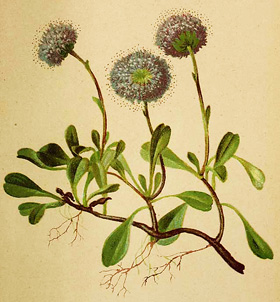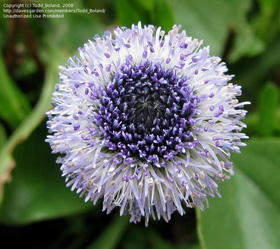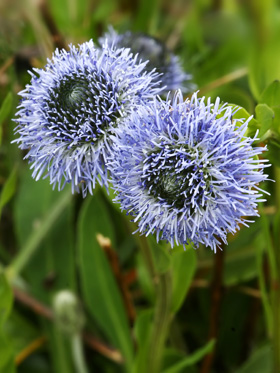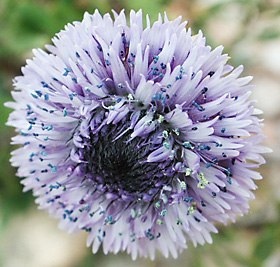





Do you like discovering unique and unusual plants? Read on to learn about this lesser-known and lesser grown genus.
Charmed by the blue lollipop look of globe daisies (Globularia spp.), I have tried sowing them several times without much success. Since the plants prefer dry conditions, seedlings damp off fairly easily.
 Perhaps it's no coincidence that stubborn and Stallsmith start with the same letters, though, as members of my family have a reputation for bullheadedness. (I prefer to call it steadfastness!) So I persisted and did succeed in germinating one seed out of seven of Globularia punctata this year.
Perhaps it's no coincidence that stubborn and Stallsmith start with the same letters, though, as members of my family have a reputation for bullheadedness. (I prefer to call it steadfastness!) So I persisted and did succeed in germinating one seed out of seven of Globularia punctata this year.
The Globularia genus seems to be divided between low-growing species, often raised in troughs or rock gardens, and taller, more shrubby types. On the former, each spherical "flower" actually is a flower head 1/2 to 1 inch across, packed with the tubular true flowers which look more like petals. The mostly evergreen plants actually are members of the plantain rather than the daisy family. They form mats or cushions of leathery foliage one to eight inches tall, with flower stalks usually no more than 12 inches in height.
 Shrubby globularias, such as alypum, indubia, and salicina grow taller, up to 3 feet, with larger leaves and showier, often bi-colored flowers. Unfortunately, shrubby types also tend to be less hardy than the lower growing varieties and usually will only survive in USDA zones 7 through 11.
Shrubby globularias, such as alypum, indubia, and salicina grow taller, up to 3 feet, with larger leaves and showier, often bi-colored flowers. Unfortunately, shrubby types also tend to be less hardy than the lower growing varieties and usually will only survive in USDA zones 7 through 11.
All types prefer full sun and very well-drained soil, in the neutral to alkaline range, plus a location which never gets soggy during the winter months. The time of bloom depends on the species and varies from spring through summer.
 If you live in one of the cold zones as I do, you probably should opt for the shorter, hardier varieties such as G. bellidifolia, G. cordifolia, G. meridionalis, punctata, or G. repens. Those of you in USDA zone 7 or higher definitely should take a stab at the shrubby types I mentioned earlier, though I would situate them in a protected location in zones lower than 9. The information available on globe daisies is scanty and often contradictory, so you may need to experiment to discover which species truly are hardy in your area.
If you live in one of the cold zones as I do, you probably should opt for the shorter, hardier varieties such as G. bellidifolia, G. cordifolia, G. meridionalis, punctata, or G. repens. Those of you in USDA zone 7 or higher definitely should take a stab at the shrubby types I mentioned earlier, though I would situate them in a protected location in zones lower than 9. The information available on globe daisies is scanty and often contradictory, so you may need to experiment to discover which species truly are hardy in your area.
Tom Clothier’s site recommends that you sow globularia seeds on the surface of your seed-sowing mix at a temperature around 68 degrees. (Due to the seedlings' requirement for well-drained soil, you might want to add some sand to that mix.) Although most species like light for germination, G. nudicaulis reportedly prefers darkness, so cover its flat with tin foil rather than plastic wrap.
 If nothing has popped up within a month, encase your seed container in a plastic bag and move it into a refrigerator or freezer for a month or so, before returning it to 68-degree conditions. Some gardeners prefer to sow the seeds in a cold frame in late autumn instead, so that they sprout in spring.
If nothing has popped up within a month, encase your seed container in a plastic bag and move it into a refrigerator or freezer for a month or so, before returning it to 68-degree conditions. Some gardeners prefer to sow the seeds in a cold frame in late autumn instead, so that they sprout in spring.
Since I'd read somewhere that G. punctata needs temperatures in the 50s for germination, I kept mine in a chilly back room until that one seedling emerged—in about 54 days. Next time, I probably should plant more seeds!
Photos: The banner photo of Globularia x indubia is by ecrane3 and the photo of Globularia meridionalis by Todd Boland, both from the Dave's Garden PlantFiles. The photo of Globularia punctata is by Hans Hillewaert, courtesy of Wikimedia Commons and this license, and the photo of Globularia alypum by Joan Simon, courtesy of Wikimedia Commons and this license. The antique image of Globularia cordifolia is from Atlas de la Flore Alpine by the German and Austrian Alpine Club, courtesy of plantillustrations.org.
Copyright © www.100flowers.win Botanic Garden All Rights Reserved